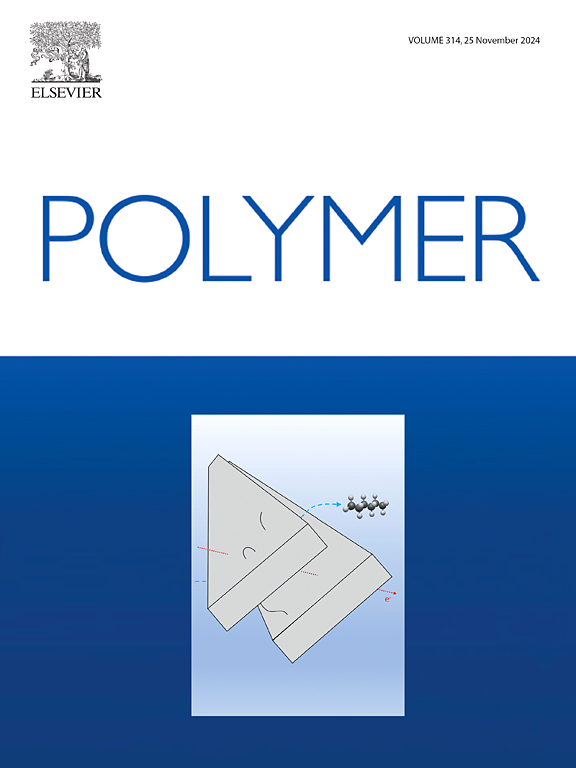分子量对聚乳酸热降解的影响:结晶的观点
IF 4.1
2区 化学
Q2 POLYMER SCIENCE
引用次数: 0
摘要
本研究采用热重分析法(TGA)系统地研究了不同分子量(S1、S2和S3分别为40.58×103、49.06×103和67.49×103 g/mol)的聚乳酸(PLA)的热降解行为。通过使用Fraser-Suzuki函数对差热重(DTG)曲线进行反褶积,确定了两种不同的降解组分:Pseudo 1(与酯交换反应有关)和Pseudo 2(与自由基反应有关)。采用四种无模型方法进行了综合动力学分析,阐明了热降解机理。结果表明,活化能(Eα)与分子量有显著的相关性。随着分子质量的增加,Eα范围呈减小趋势,S1、S2和S3的Eα范围分别为152 ~ 247、144 ~ 232和111 ~ 197 kJ/mol。分子量与Eα之间的负相关关系表明,低分子量PLA表现出较慢的热降解动力学和增强的热稳定性。利用Liu-Mo和Kissinger方法对非等温冷结晶动力学进行了互补分析,结果表明分子量的降低导致F(T)值的升高。计算得到的S1、S2和S3的冷结晶活化能(ΔE)分别为66.17 kJ/mol、70.92 kJ/mol和85.76 kJ/mol,加快了低分子量PLA的结晶动力学。从结晶角度看,低分子量的聚乳酸表现出更强的非等温冷结晶能力,形成更丰富的层状晶体。这种晶体结构在热降解过程中保持了长聚合物链的完整性,从而降低了降解速度,提高了整体热稳定性。该研究建立了聚乳酸分子量、结晶和热降解机制之间的基本关系。本文章由计算机程序翻译,如有差异,请以英文原文为准。


Influence of molecular weight on the thermal degradation of poly(lactic acid): A crystallization perspective
In this study, the thermal degradation behavior of poly(lactic acid) (PLA) with different molecular weights (S1, S2 and S3 are 40.58 × 103, 49.06 × 103 and 67.49 × 103 g/mol, respectively), was systematically investigated using thermogravimetric analysis (TGA). Through deconvolution of differential thermogravimetric (DTG) curves using the Fraser-Suzuki function, two distinct degradation components were identified: Pseudo 1 (associated with ester exchange reactions) and Pseudo 2 (associated with free radical reactions). A comprehensive kinetic analysis was performed using four model-free methods to elucidate the thermal degradation mechanism. The results revealed a significant molecular weight dependence of activation energies (Eα). The Eα range had a decreasing trend with the increase of molecular weight, which were 152∼247, 144–232, and 111–197 kJ/mol for S1, S2 and S3, respectively. This inverse correlation between molecular weight and Eα indicates that lower molecular weight PLA exhibits slower thermal degradation kinetics and enhanced thermal stability. Complementary analysis of non-isothermal cold crystallization kinetics using Liu-Mo and Kissinger methods demonstrated that decreasing molecular weight resulted in higher F(T) values. The calculated activation energies (ΔE) for cold crystallization were 66.17 kJ/mol, 70.92 kJ/mol, and 85.76 kJ/mol for S1, S2 and S3, respectively, which accelerated crystallization kinetics in lower molecular weight PLA. From a crystallization perspective, lower molecular weight PLA exhibited superior non-isothermal cold crystallization capability, forming more abundant lamellar crystals. This crystalline architecture preserves the integrity of long polymer chains during thermal degradation, thereby decelerating degradation rates and improving overall thermal stability. The study establishes a fundamental relationship between molecular weight, crystallization, and thermal degradation mechanisms in PLA.
求助全文
通过发布文献求助,成功后即可免费获取论文全文。
去求助
来源期刊

Polymer
化学-高分子科学
CiteScore
7.90
自引率
8.70%
发文量
959
审稿时长
32 days
期刊介绍:
Polymer is an interdisciplinary journal dedicated to publishing innovative and significant advances in Polymer Physics, Chemistry and Technology. We welcome submissions on polymer hybrids, nanocomposites, characterisation and self-assembly. Polymer also publishes work on the technological application of polymers in energy and optoelectronics.
The main scope is covered but not limited to the following core areas:
Polymer Materials
Nanocomposites and hybrid nanomaterials
Polymer blends, films, fibres, networks and porous materials
Physical Characterization
Characterisation, modelling and simulation* of molecular and materials properties in bulk, solution, and thin films
Polymer Engineering
Advanced multiscale processing methods
Polymer Synthesis, Modification and Self-assembly
Including designer polymer architectures, mechanisms and kinetics, and supramolecular polymerization
Technological Applications
Polymers for energy generation and storage
Polymer membranes for separation technology
Polymers for opto- and microelectronics.
 求助内容:
求助内容: 应助结果提醒方式:
应助结果提醒方式:


